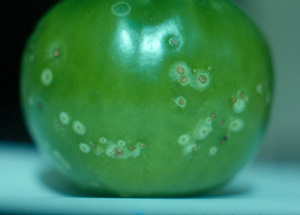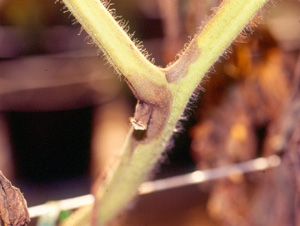Tomato – Bacterial Canker

Bacterial Canker, tomato
Photo: Dr. Wayne Nishijima
Problem
Tomatoes afflicted with bacterial canker show lower leaves that wilt and dry up while still attached to the plant. Vascular tissue is discolored and yellow slime can be squeezed from the stems.
Description
Symptoms include wilting and cankers on both stems and fruits. A canker is a sunken, necrotic lesion.
Information
- CTAHR – Farmer’s Bookshelf – Vegetables – Tomato
- Texas A&M AgriLife Extension – Vegetable Production – Tomato Problem Solver - Disorders of tomato leaf

Bacterial Canker, stem
Photo: Dr. Wayne Nishijima
Control
This disease is seed borne, so it is important to use disease free seed. It can also be soil borne, so soil in infected areas should be sterilized. Because Bacterial canker can remain in the soil for years, we recommend that you rotate crops, practice good sanitation, and use disease-resistant varieties. Avoid mechanical damage to plants to prevent possible spread of the bacterium as well.
Contaminated seed may be treated in the following way, according to CTAHR (see Farmer’s Bookshelf):
- Fermentation: ferment crushed pulp for 96 hours before extracting seed at temperatures near 70F. Stir it at least twice a day.
- Acid: Soak freshly extracted seed in an 0.8% acetic acid solution. This is done by adding 1 fluid oz. of acetic acid to 1 gallon of water. Place seed in loosely woven cloth and immerse in solution for 24 hr at 70F.
Kendal Lyon, Hawaii Island Master Gardeners

